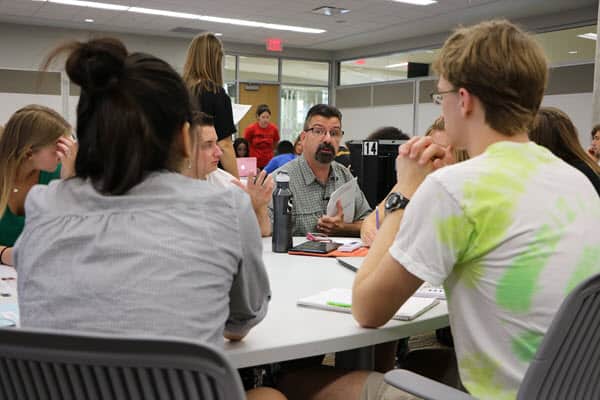By Doug Ward
When Mark Mort began remaking a 100-level biology course a few years ago, he asked instructors who had taught the class what they thought students needed.
“Not surprisingly, the answers were very much content, content, content,” said Mort, an associate professor of ecology and evolutionary biology.
Then he went to colleagues who taught classes later in the curriculum, courses for which his course, Biology 152, was a prerequisite. He asked what they expected students to know after taking Biology 152, or Principles of Organismal Biology.
Their response?
Nothing.
That’s right. Nothing. They told Mort: “We don’t think they have any content retention.”
The response was both sobering and liberating, reminding Mort of the course’s weaknesses but helping justify a major remake.
Biology 152 is the first of a two-course sequence that most biology majors take. It had long been taught as a lecture to 400 or more students, with instructors using PowerPoint slides to “plow through as much material and content as possible,” Mort said.
Mort knew the course had problems.
“We were losing a lot of students because we were trying cover a lot of material in a very rapid fashion,” he said.
So he set out to change the course in several ways:
- Creating “high-reward, low-risk” activities, both in class and out of class, to help students learn material along the way rather than forcing them to cram for exams
- Lecturing less and integrating more discussion, case studies, problem-solving and application of material, even in a class that often had more than 400 students
- Helping students improve their study skills
- Focusing on activities that help students think like a scientist, including improving their understanding of scientific method, their ability to read scientific papers, and their ability to interpret charts and graphs
All too often, Mort said, faculty members get lost in the content and forget about the things that fascinated and inspired them early in their careers.
“And I think if we don’t step back and say, ‘This is why I’m a biologist’ or ‘This is why I’m a psychologist,’ we don’t get the excitement in the next generation of students,” Mort said.
The transformation is working. Students are more engaged. The number of those who drop or fail has declined. Instructors are enjoying the teaching of the class more. And Mort is able to have new conversations with his colleagues.
“It’s allowing me to go to my colleagues downstream and say, ‘The students in Biology 152 were held accountable for this information at this level of knowledge, and you don’t have to feel compelled to go back to the very basics because they have some of this content already.’ The price is we don’t cover 15 chapters on human anatomy and physiology or mammalian physiology. I don’t think we need to. I don’t think we ever should have tried to do that.”
In other words, it’s no longer all about the content.
Doug Ward is the associate director of the Center for Teaching Excellence and an associate professor of journalism. You can follow him on Twitter @kuediting.




Recent Comments